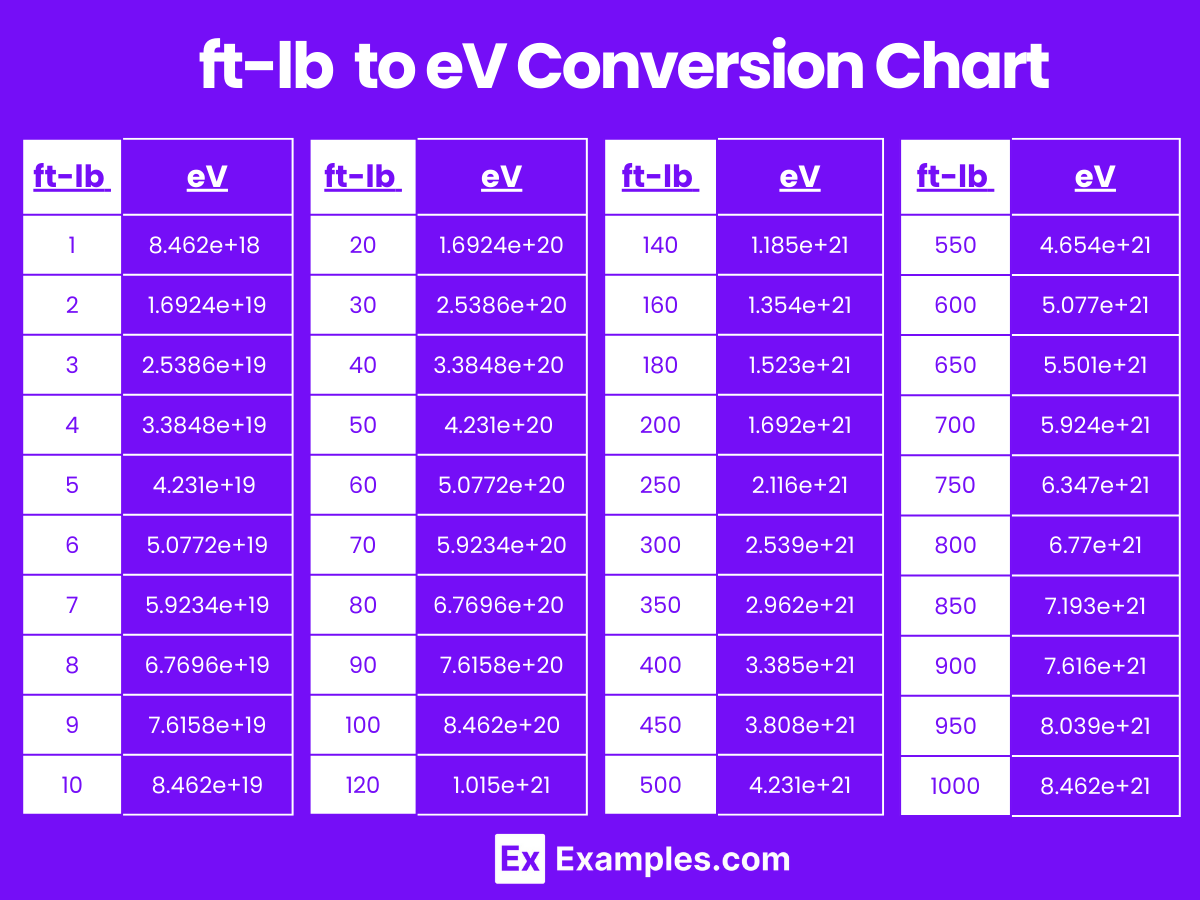Effortlessly convert electronvolts to foot-pounds and vice versa with Examples.com. Input your data for immediate conversion results.
eV to ft-lb
Formula: Energy in Foot-pounds (ft-lb) = Energy in Electronvolt (eV) x 1.181705E-19
Electronvolt :
Foot-pound :
| Electronvolt | Foot-pounds |
|---|---|
| 1 | 1.181705e-19 |
ft-lb to eV
Formula: Energy in Electronvolt (eV) = Energy in Foot-pounds (ft-lb) ÷ 1.181705E-19
Foot-pound :
Electronvolt :
| Foot-pounds | Electronvolt |
|---|---|
| 1 | 8462348894182558000 |
Energy Converters to Electronvolt
Energy Converters to Foot-pound
Conversion Factors:
- Electronvolt to Foot-pound: 1 electronvolt (eV) = 1.1817e-19 foot-pounds (ft-lb)
- Foot-pound to Electronvolt: 1 foot-pound (ft-lb) = 1 / 1.1817e-19 electronvolts (eV)
How to Convert Electronvolt to Foot-pound:
To convert electronvolts to foot-pounds, multiply the number of electronvolts by 1.1817e-19.
Foot-pound=Electronvolt×1.1817e−19
Example:
Convert 5,000,000,000,000,000,000 electronvolts to foot-pounds.
Foot-pound=5,000,000,000,000,000,000×1.1817e−19=0.59085 ft-lb
How to Convert Foot-pound to Electronvolt:
To convert foot-pounds to electronvolts, divide the number of foot-pounds by 1.1817e-19.
Electronvolt=Foot-pound/1.1817e−19
Example:
Convert 2 foot-pounds to electronvolts.
Electronvolt=2/1.1817e−19=1.6924×1019 eV
Electronvolt to Foot-pound Conversion Table
| Electronvolt (eV) | Foot-pound (ft-lb) |
|---|---|
| 1 eV | 1.1817e-19 ft-lb |
| 2 eV | 2.3634e-19 ft-lb |
| 3 eV | 3.5451e-19 ft-lb |
| 4 eV | 4.7268e-19 ft-lb |
| 5 eV | 5.9085e-19 ft-lb |
| 6 eV | 7.0902e-19 ft-lb |
| 7 eV | 8.2719e-19 ft-lb |
| 8 eV | 9.4536e-19 ft-lb |
| 9 eV | 1.0635e-18 ft-lb |
| 10 eV | 1.1817e-18 ft-lb |
| 20 eV | 2.3634e-18 ft-lb |
| 30 eV | 3.5451e-18 ft-lb |
| 40 eV | 4.7268e-18 ft-lb |
| 50 eV | 5.9085e-18 ft-lb |
| 60 eV | 7.0902e-18 ft-lb |
| 70 eV | 8.2719e-18 ft-lb |
| 80 eV | 9.4536e-18 ft-lb |
| 90 eV | 1.0635e-17 ft-lb |
| 100 eV | 1.1817e-17 ft-lb |
eV to ft-lb Conversion Chart

Foot-pound to Electronvolt Conversion Table
| Foot-pound (ft-lb) | Electronvolt (eV) |
|---|---|
| 1 ft-lb | 8.462e+18 eV |
| 2 ft-lb | 1.6924e+19 eV |
| 3 ft-lb | 2.5386e+19 eV |
| 4 ft-lb | 3.3848e+19 eV |
| 5 ft-lb | 4.231e+19 eV |
| 6 ft-lb | 5.0772e+19 eV |
| 7 ft-lb | 5.9234e+19 eV |
| 8 ft-lb | 6.7696e+19 eV |
| 9 ft-lb | 7.6158e+19 eV |
| 10 ft-lb | 8.462e+19 eV |
| 20 ft-lb | 1.6924e+20 eV |
| 30 ft-lb | 2.5386e+20 eV |
| 40 ft-lb | 3.3848e+20 eV |
| 50 ft-lb | 4.231e+20 eV |
| 60 ft-lb | 5.0772e+20 eV |
| 70 ft-lb | 5.9234e+20 eV |
| 80 ft-lb | 6.7696e+20 eV |
| 90 ft-lb | 7.6158e+20 eV |
| 100 ft-lb | 8.462e+20 eV |
ft-lb to eV Conversion Chart

Difference Between Electronvolt to Foot-pound
| Feature | Electronvolt (eV) | Foot-pound (ft-lb) |
|---|---|---|
| Definition | A unit of energy commonly used in the field of particle physics. | A unit of energy commonly used in engineering and physics. |
| Abbreviation | eV | ft-lb |
| Energy Scale | Suitable for atomic and subatomic particles | Suitable for macroscopic mechanical systems |
| Conversion Factor | 1 eV = 1.1817e-19 ft-lb | 1 ft-lb = 8.462e+18 eV |
| Typical Usage | Used to measure the energy of electrons and other subatomic particles. | Used to measure the energy of mechanical systems, such as engines. |
| Practical Example | Energy gained by an electron when accelerated through a potential difference of one volt. | Energy required to lift a one-pound weight a distance of one foot. |
| Scientific Relevance | Crucial in the fields of quantum mechanics and particle physics. | Important in classical mechanics and engineering applications. |
| Unit System | Part of the metric system and commonly used in scientific research. | Part of the Imperial system and commonly used in practical engineering. |
1. Solved Examples on Converting Electronvolt to Foot-pound
Example 1: Convert 1 electronvolt to foot-pounds
Foot-pound=1×1.1817e−19
Foot-pound=1.1817e−19
Example 2: Convert 5 electronvolts to foot-pounds
Foot-pound=5×1.1817e−19
Foot-pound=5.9085e−19
Example 3: Convert 10 electronvolts to foot-pounds
Foot-pound=10×1.1817e−19
Foot-pound=1.1817e−18
Example 4: Convert 50 electronvolts to foot-pounds
Foot-pound=50×1.1817e−19
Foot-pound=5.9085e−18
Example 5: Convert 100 electronvolts to foot-pounds
Foot-pound=100×1.1817e−19
Foot-pound=1.1817e−17
2. Solved Examples on Converting Foot-pound to Electronvolt
Example 1: Convert 1 foot-pound to electronvolts
Electronvolt=1 ft-lb/1.1817e−19
Electronvolt=8.462e18eV
Example 2: Convert 5 foot-pounds to electronvolts
Electronvolt=5 ft-lb/1.1817e−19
Electronvolt=4.231e19eV
Example 3: Convert 10 foot-pounds to electronvolts
Electronvolt=10 ft-lb/1.1817e−19
Electronvolt=8.462e19eV
Example 4: Convert 50 foot-pounds to electronvolts
Electronvolt=50 ft-lb/1.1817e−19
Electronvolt=4.231e20eV
Example 5: Convert 100 foot-pounds to electronvolts
Electronvolt=100 ft-lb/1.1817e−19
Electronvolt=8.462e20eV
Where is the conversion of electronvolts to foot-pounds most commonly used?
The conversion is commonly used in fields that require an understanding of both macroscopic and microscopic energy scales, such as materials science, particle physics, and certain engineering disciplines.
Why do we need to convert electronvolts to foot-pounds?
Converting electronvolts to foot-pounds is necessary in certain scientific and engineering applications where different units of energy are used. Electronvolts are commonly used in atomic and subatomic physics, while foot-pounds are used in classical mechanics and engineering.
What tools can I use to convert electronvolts to foot-pounds?
You can use calculators, online conversion tools, or even spreadsheet software like Excel to perform these conversions quickly and accurately.
What are some practical applications of this conversion?
This conversion is useful in fields such as nuclear physics, quantum mechanics, and electrical engineering, where both microscopic and macroscopic energy measurements are important.
How does the energy scale of electronvolts compare to foot-pounds?
Electronvolts are used for very small energy scales, such as atomic and subatomic particles, while foot-pounds are used for larger energy scales in mechanical systems.

